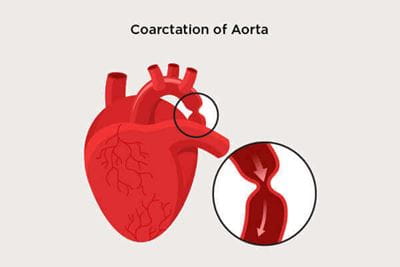What Is Coarctation of the Aorta?
 It's a type of heart disease present at birth that causes a narrowing in the aorta. The aorta is the blood vessel that supplies our bodies with oxygen-rich blood.
It's a type of heart disease present at birth that causes a narrowing in the aorta. The aorta is the blood vessel that supplies our bodies with oxygen-rich blood.
A narrowing in the aorta prevents blood flow to the lower body. This can cause problems with feeding and weight gain in infants and sometimes serious illness if severe.
Surgeons often repair the narrowing as an infant. At times, the narrowing comes back, and we address it in the Heart Cath Lab at UPMC Children's Hospital of Pittsburgh.
Older people may have high blood pressure in their arms and low blood pressure in the legs. If it’s severe, they may have symptoms such as sore legs or headaches.
Adults with long-standing coarctation have an increased risk of stroke.
Refer a Patient to the Interventional Cardiology Program at UPMC Children's Hospital
To refer a patient, doctors can:
How Do You Treat Coarctation of the Aorta in the Cath Lab?
In the cath lab, we use a balloon to widen the vessel (angioplasty). We may order am MRI or CT scan before or after the procedure.
During this minimally invasive treatment for coarctation of the aorta, your doctor will:
- Make a small incision in your groin and insert a special catheter with a balloon on the end into the narrowed vessel.
- Inflate the balloon briefly, and then deflate it. The hope is that this will enlarge the vessel.
- Remove the balloon and catheter.
If you're older, we may place a stent to keep the vessel open if balloon dilation alone doesn't work.
After balloon dilation or stenting of the aorta, you'll stay overnight in the hospital so we can observe you.









 It's a type of heart disease present at birth that causes a narrowing in the aorta. The aorta is the blood vessel that supplies our bodies with oxygen-rich blood.
It's a type of heart disease present at birth that causes a narrowing in the aorta. The aorta is the blood vessel that supplies our bodies with oxygen-rich blood.